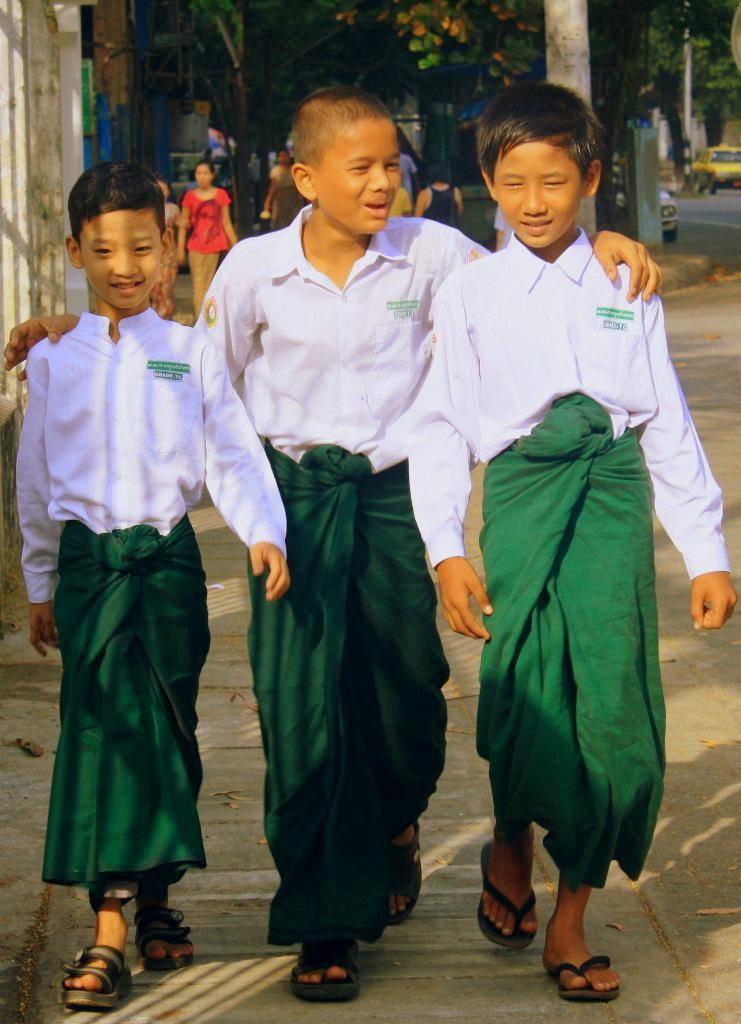
Burmese Schools

Figure 1.--Here we see Burmese schoolboys in their uniforms. The photo was taken in Mandalay during 2011. Notice the mixture of western white shirts and a kind of Burmese traditional green wrap skirts. traditional garments are not common in schools ariund the world. This is a reflection in part of hostility to the west. It certainly is not practicality.
|
|
After World War II, European colonies looked to the future and what they were sure would be independence and properity which would be insured by socialism. Today we here nothing but invictive about colonialism, much of it deserved. Almost never said is how the new indepence leaders turned prosperous British colonies into povery stricken countries. Burma is one of the best examples. Burma before World War II was a British colony which along with India was granted independence after the War. The Burmese and many others expected it to be one of the Asian suscess stories. Just the opposite occurred. There would be spectacular successes in Asia, but Burma would not be one of them. A mixture of socialism and hostility to the west were both factors. And nothing shows this better than the unravlling of a once impressive education system. The successes were those countries embracing capitalism and engaged with the west. Burma before the War and Japanese invasion was admired for the widespread literacy and high educational standards. It had one of the highest literacy rates in Asia. Both the economy and education system slowly crumbled under the socilist economy introduced and the authoritarian rule. Burma's educational system is now one of the weakest in the region. The United Nations Development Programís Human Development Index, ranks Burma an incredibe 164th, out of 168 countries in terms of expenditure on education -- only 1.3 percent of its GDP on education. [UNESCO, 2001.] As a result, the once proud education system has disintegrated. And remember that Burma had an education system before independence and many of the countries that now rank above Burma had no substantial public education systems at the time of independence. Burmese children spend relatively little time in school. Only a handful reach university. And university students not only face high fees, but are not allowed to select their field of study. Government officials assign courses based on test scores of matriculation exam. Student interest and desires and the availability of jobs are ignored. [Fink, p. 197.] We do not yet have a page on Burmese schools. We do note St Paul's High School a Catholic school in Rangoon established during the British colonial period. We have a class photo taken in 1957 and a photo showing a Catholic group at the school in 1955. We do not know if the school still exists. We notices students wearing hite shirts and green wrap skirts (figure 1). This may be a national school uniform. One unique feature of Burmese education is the use of cosmestics. Women commonly use thanaka, a cosmetic paste made from ground bark. It is not a beauty comestic as in the West, but a skin care cosmetic which has been found to have theraputic benefits. It is porimarily used by women, but mothers in rural areas commonly apply it to the faces of children before sending them off to school.
Sources
Fink, Christina. Living Silence in Burma.
UNESCO.
Additional Information
Careful, clicking on these will exit you from the Boys' Historical Clothing web site, but several are highly recommended
British Preparatory Schools: A photographic book depicting life at British preparatory schools during the 1980s. Most of the schools are English or Scottish, but schools in Italy, New Zealand, South Africa, and Ulster are also included. The pictures show the uniforms worn at many different schools.
New Zeeland Schools: A photographic E-book depicting life at New Zeeland schools
British Preparatoru Schools: New Apertures E-book on British preparatory schools available
HBC-SU

Related Chronolgy Pages in the Boys' Historical Web Site
[Late 19th century]
[The 1930s]
[The 1940s]
[The 1930s]
[The 1940s]
[The 1950s]
[The 1960s]
[The 1970s]
[The 1980s]
Related Style Pages in the Boys' Historical Web Site
[Long pants suits]
[Knicker suits]
[Short pants suits]
[Socks]
[Eton suits]
[Jacket and trousers]
[Blazer]
[School sandals]
Navigate the HBC School section
[Return to the Main Asian school page]
[Return to the Main Burmese country page]
[About Us]
[Activities]
[Chronology]
[Clothing styles]
[Countries]
[Debate]
[Economics]
[Garment]
[Gender]
[Hair]
[History]
[Home trends]
[Literary characters]
[School types]
[Significance]
[Transport and travel
[Uniform regulations]
[Year level]
[Other topics]
[Images]
[Links]
[Registration]
[Tools]
[Return to the Historic Boys' School Home]
Created: 6:58 AM 10/5/2015
Last updated: 2:44 AM 5/7/2018




